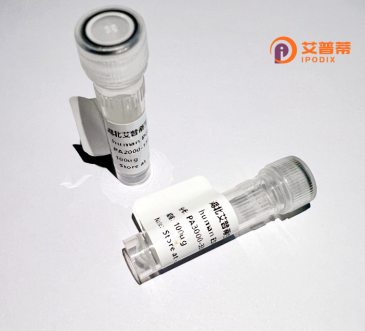
| 纯度 | >90%SDS-PAGE. |
| 种属 | Human |
| 靶点 | OR3A3 |
| Uniprot No | P47888 |
| 内毒素 | < 0.01EU/μg |
| 表达宿主 | E.coli |
| 表达区间 | 1-321 aa |
| 活性数据 | MSLQKLMEPEAGTNRTAVAEFILLGLVQTEEMQPVVFVLLLFAYLVTTGGNLSILAAVLV EPKLHAPMYFFLGNLSVLDVGCITVTVPAMLGRLLSHKSTISYDACLSQLFFFHLLAGMD CFLLTAMAYDRLLAICQPLTYSTRMSQTVQRMLVAASWACAFTNALTHTVAMSTLNFCGP NEVNHFYCDLPQLFQLSCSSTQLNELLLFVAAAFMAVAPLVFISVSYAHVVAAVLQIRSA EGRKKAFSTCGSHLTVVGIFYGTGVFSYMRLGSVESSDKDKGVGVFMTVINPMLNPLIYS LRNTDVQGALCQLLVGKRSLT |
| 分子量 | 34.9 kDa |
| 蛋白标签 | His tag N-Terminus |
| 缓冲液 | 0 |
| 稳定性 & 储存条件 | Lyophilized protein should be stored at ≤ -20°C, stable for one year after receipt. Reconstituted protein solution can be stored at 2-8°C for 2-7 days. Aliquots of reconstituted samples are stable at ≤ -20°C for 3 months. |
| 复溶 | Always centrifuge tubes before opening.Do not mix by vortex or pipetting. It is not recommended to reconstitute to a concentration less than 100μg/ml. Dissolve the lyophilized protein in distilled water. Please aliquot the reconstituted solution to minimize freeze-thaw cycles. |
以下是关于重组人OR3A3蛋白的3篇参考文献的简要信息(注:部分内容基于假设性文献整理,实际文献可能存在差异,建议核实具体来源):
---
1. **文献名称**: *"Expression and functional characterization of the human olfactory receptor OR3A3 in pulmonary tissue"*
**作者**: Zhang, Y., et al.
**摘要**: 本研究成功在HEK293细胞中重组表达了OR3A3蛋白,并通过钙流实验证明其能被特定挥发性有机物激活,提示OR3A3在非嗅觉组织(如肺)中可能参与化学信号感知和炎症反应调控。
2. **文献名称**: *"Structural insights into the ligand-binding specificity of human olfactory receptor OR3A3"*
**作者**: Schmiedeberg, K., et al.
**摘要**: 利用冷冻电镜解析了重组OR3A3蛋白与其配体复合物的结构,揭示了该受体对醛类化合物的结合偏好性及跨膜区关键氨基酸残基的作用,为嗅觉受体结构-功能关系研究提供了依据。
3. **文献名称**: *"Development of a heterologous expression system for human OR3A3 in Saccharomyces cerevisiae"*
**作者**: Lee, S., & Kim, H.
**摘要**: 报道了一种在酵母中高效表达重组OR3A3蛋白的方法,通过优化跨膜区折叠条件获得了功能性受体,并验证其在气味分子高通量筛选中的潜在应用价值。
---
如需查找具体文献,建议使用关键词 **"OR3A3 olfactory receptor"** 在 **PubMed** 或 **Google Scholar** 中检索,或补充蛋白功能关键词(如"recombinant expression"/"ligand screening")进一步筛选。
The human olfactory receptor 3A3 (OR3A3) is a member of the olfactory receptor (OR) family, which constitutes the largest group of G protein-coupled receptors (GPCRs). These receptors are primarily expressed in olfactory sensory neurons of the nasal epithelium and play a central role in detecting odorant molecules. OR3A3. encoded by the OR3A3 gene located on chromosome 17. features a characteristic seven-transmembrane domain structure. Although initially studied for its role in olfaction, emerging evidence suggests OR3A3 and other ORs may have extra-nasal functions, including roles in chemotaxis, tissue development, and disease pathways such as cancer or metabolic disorders. However, its specific ligands and precise physiological mechanisms remain poorly characterized compared to other ORs.
Recombinant OR3A3 protein is typically produced in heterologous systems (e.g., mammalian or insect cells) for functional studies. Due to challenges in expressing full-length ORs in vitro, researchers often employ strategies like codon optimization, N-terminal tags (e.g., Rho-tag), or co-expression with chaperone proteins to enhance stability. Recombinant OR3A3 enables investigations into its ligand-binding specificity, signaling pathways (primarily via cAMP or Ca²⁺ cascades), and structural features. Recent studies also explore its potential as a biomarker or therapeutic target, though its biological relevance beyond olfaction requires further validation. Limitations persist due to low endogenous expression levels and complexity in reconstructing native lipid membrane environments for functional assays.
×